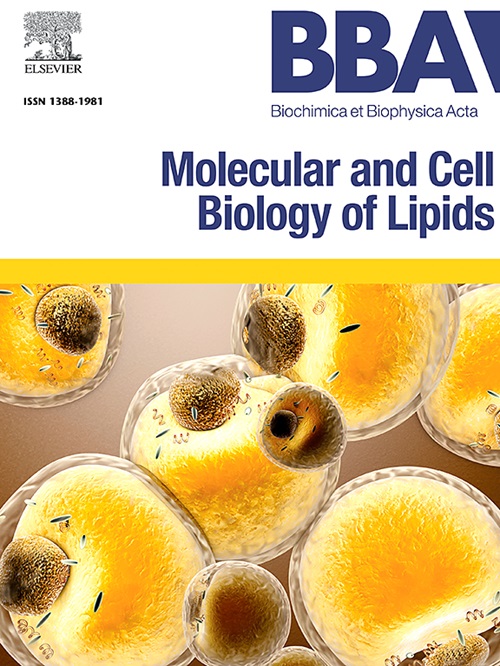含有n-3和n-6脂肪酸的磷脂酰乙醇胺可以调节巨噬细胞脂质组,并减弱对LPS刺激的反应
IF 3.3
2区 生物学
Q2 BIOCHEMISTRY & MOLECULAR BIOLOGY
Biochimica et biophysica acta. Molecular and cell biology of lipids
Pub Date : 2025-04-18
DOI:10.1016/j.bbalip.2025.159614
引用次数: 0
摘要
磷脂越来越被认为是生物过程的关键调节剂,包括巨噬细胞的极化和功能。其中,磷脂酰乙醇胺(PE)是细胞膜的主要成分,在维持细胞结构和功能中起着关键作用,但天然PE物种影响巨噬细胞免疫代谢的机制仍未得到充分研究。本研究探讨了两种天然PE (PE 18:0/22:6和PE 18:0/20:4)对静息和lps活化巨噬细胞脂质组的影响。利用C18高效液相色谱-质谱联用技术,我们鉴定了15个脂质亚类中的337种脂质分子,其中332种在不同条件下变化显著。在基础条件下,补充PE 18:0/22:6和PE 18:0/20:4均可调节巨噬细胞脂质组,而不诱导促炎表型。值得注意的是,添加PE 18:0/22:6和PE 18:0/20:4显著增加了PE、PE O-、SM、CL、PG、LPE和PS等脂类,产生了独特的脂质谱。PE 18:0/22:6和PE 18:0/20:4预处理部分减弱了lps诱导的脂质组学变化,显著降低了通常与炎症相关的脂质类别,如PC,包括PC O-和PC P-,以及Cer。从单个脂质物种的角度来看,PE 18:0/20:4可能促进与促炎信号通路相容的某些脂质谱,特别是在炎症条件下,PE 18:0/22:6似乎促进了更支持炎症解决的脂质谱。PE 18:0/22:6和PE 18:0/20:4的这种行为突出了脂质介导的免疫调节的复杂性,并强调了细胞环境在决定巨噬细胞脂质代谢和免疫应答中磷脂补充的功能结果中的关键作用。本文章由计算机程序翻译,如有差异,请以英文原文为准。
Phosphatidylethanolamine species with n-3 and n-6 fatty acids modulate macrophage lipidome and attenuate responses to LPS stimulation
Phospholipids are increasingly recognized as key regulators of biological processes, including macrophage polarization and function. Among these, phosphatidylethanolamine (PE), a major constituent of cell membranes, is pivotal in maintaining cellular structure and function, yet the mechanisms through which native PE species influence macrophage immunometabolism remain largely unexplored. This study investigates the effects of two native PE species, PE 18:0/22:6 and PE 18:0/20:4, on the lipidome of resting and LPS-activated macrophages. Using C18 HPLC-MS/MS, we identified 337 lipid molecular species across 15 lipid subclasses, 332 of which varied significantly among conditions. Both PE 18:0/22:6 and PE 18:0/20:4 supplementation modulated the macrophage lipidome without inducing a pro-inflammatory phenotype under basal conditions. Notably, supplementation with PE 18:0/22:6 and PE 18:0/20:4 significantly increased lipid classes such as PE, PE O-, SM, CL, PG, LPE and PS, producing unique lipid profiles. Pre-treatment with PE 18:0/22:6 and PE 18:0/20:4 partially attenuated LPS-induced lipidomic changes, significantly reducing lipid classes like PC, including PC O- and PC P-, and Cer, which are typically linked to inflammation. While PE 18:0/20:4, from an individual lipid species perspective, may promote certain lipid profiles compatible with pro-inflammatory signaling pathways, particularly under inflammatory conditions, PE 18:0/22:6 seems to foster a lipid profile more supportive of inflammation resolution. This behaviour of PE 18:0/22:6 and PE 18:0/20:4 highlights the intricate complexity of lipid-mediated immunomodulation and emphasizes the critical role of cellular context in determining the functional outcomes of phospholipid supplementation in macrophage lipid metabolism and immune responses.
求助全文
通过发布文献求助,成功后即可免费获取论文全文。
去求助
来源期刊
CiteScore
11.00
自引率
2.10%
发文量
109
审稿时长
53 days
期刊介绍:
BBA Molecular and Cell Biology of Lipids publishes papers on original research dealing with novel aspects of molecular genetics related to the lipidome, the biosynthesis of lipids, the role of lipids in cells and whole organisms, the regulation of lipid metabolism and function, and lipidomics in all organisms. Manuscripts should significantly advance the understanding of the molecular mechanisms underlying biological processes in which lipids are involved. Papers detailing novel methodology must report significant biochemical, molecular, or functional insight in the area of lipids.

 求助内容:
求助内容: 应助结果提醒方式:
应助结果提醒方式:


